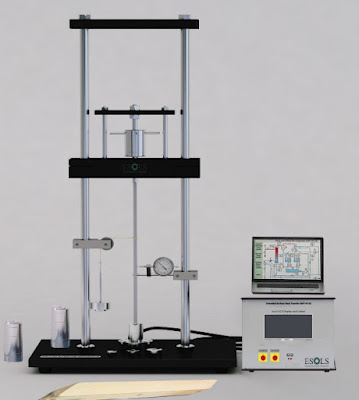Search This Blog
Most Popular
Categories
- Building Construction (84)
- Building Materials (82)
- Columns (2)
- Concrete Beam (3)
- Concrete Construction Techniques (4)
- Concrete Mix Design (9)
- Concrete Repair (14)
- Concrete Slab (10)
- Construction Equipment (16)
- Construction News (7)
- Design of Structures (15)
- Engineering Drawing (1)
- Estimation (3)
- Geotechnical engineering (26)
- Highway Engineering (11)
- Innovations (30)
- Material Testing (10)
- Matrix Analysis of Structures (2)
- Mechanical Engineering (3)
- Strength of Materials (2)
- Structural Analysis (17)
- Structural Design (21)
- Structures (17)
- Transportation Engineering (9)
Strut Test - Determination of Euler's Buckling Load
The buckling load of a strut is defined as the load at which the strut buckles, under the action of an external load. It is also called a critical load or crippling load.
A buckling load test on the strut is conducted to evaluate the effect of specimen length on the buckling of the strut, and the failure load with the theoretical failure loads obtained using Euler's equation for column/strut buckling.
Note: Columns and struts are axial compression members. Columns are short and vertical, while struts are more slender compared to columns. A slender thin rod is more likely to buckle compared to a stout rod.
Euler's Buckling Load Strut
Buckling occurs when the compressive stress of the member is within the range of linear elasticity or less than the yield stress. This happens suddenly without warning and could cause dangerous failures. Hence, buckling is an elastic stability problem.
There is a critical load limit above which buckling can occur, which is dependent on the slenderness (kL/r) of the rod and the type of material of the strut. This load is called Euler's load.
Euler's Formula for Column Buckling Load
The theoretical equation to determine Euler's buckling load is given are:
 |
| Effective Length Le related to the Actual Length L for Different End Conditions of Columns |
Laboratory Test for Buckling Load of Struts
Equipment Required
 |
| Fig.2. Strut Column Test Equipment with Touch LCD Display |
 |
| Fig.3. Strut Column Test Equipment with Force Guage |
Test Procedure
 |
| Fig.4. Positioning the Strut buckling test equipment |
- Case 1: Two Ends Pinned-Place the strut member on the V notch on the adapters.
- Case 2: When One End is Pinned and Another End is Fixed-Place the top end of the strut in a V notch and the bottom end is fixed at the bottom.
- Case 3: When Both Ends are Fixed-Fix the strut at the top and bottom.
- Case 1: Two Ends Pinned Pcr = Π2EI/L2
- Case 2: When One End is Pinned and Another End is Fixed-Place the top end of the strut in a V notch and the bottom end is fixed at the bottom. Pcr = 2Π2EI/L2
- Case 3: When Both Ends are Fixed Pcr = 4Π2EI/L2
Observations and Calculations
|
Strut Number |
Length (mm) |
Buckling Load (N) |
Average Buckling Load (N) |
|||
|
1 |
2 |
3 |
4 |
|||
|
1 |
520 |
|
|
|
|
|
|
2 |
470 |
|
|
|
|
|
|
3 |
420 |
|
|
|
|
|
|
4 |
370 |
|
|
|
|
|
|
5 |
320 |
|
|
|
|
|



0 Comments
Commenting Spam Links Are Against Policies